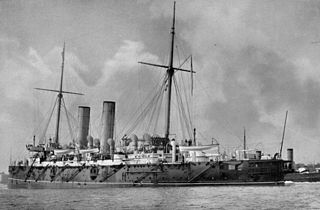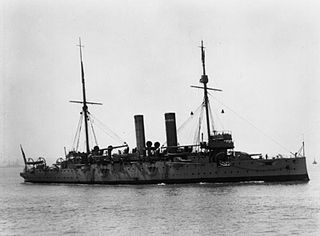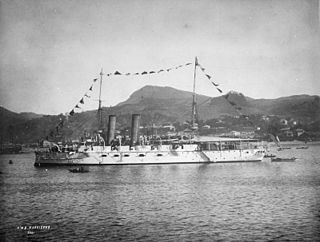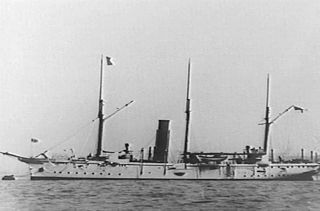
HMS Australia was one of seven Orlando-class armoured cruisers built for the Royal Navy in the mid-1880s. She was assigned to the Mediterranean Fleet in 1889 and remained there until 1893 when she returned home. The ship was assigned to the Coast Guard Squadron for the next decade before she was placed in reserve in 1903. Australia was sold for scrap in 1905.

HMS Galatea was one of seven Orlando-class armoured cruisers built for the Royal Navy in the mid-1880s. She was sold for scrap on 5 April 1905.

The Drake class was a four-ship class of armoured cruisers built around 1900 for the Royal Navy.

The Devonshire-class cruiser was a group of six armoured cruisers built for the Royal Navy in the first decade of the 20th century. All ships of the class served in World War I. Argyll was wrecked, and Hampshire was sunk by a naval mine. The four survivors were disposed of soon after the war.

The Edgar class were nine first-class protected cruisers built for the Royal Navy under the Naval Defence Act of 1889. The class gave long service and all of the ships participated in the First World War. One, HMS Hawke, was lost during the war, with the other eight being scrapped in the 1920s.

The Diadem-class cruiser was a class of "first class" protected cruiser built for the Royal Navy during the 1890s that served in the First World War. The class consisted of eight ships, built at a cost of around £600,000 each.

The Powerful class were a pair of first-class protected cruisers built for the Royal Navy (RN) in the 1890s, designed to hunt down enemy commerce raiders. Both ships served on the China Station and participated in the Second Boer War of 1899–1900. Terrible went on to help suppress the Boxer Rebellion a few months later. Powerful served as the flagship of the Australia Station in 1905–1912; shortly after her return home, she became a training ship and remained in that role until she was sold for scrap in 1929. Terrible was mostly in reserve after she returned home in 1902 and was often used as an accommodation ship. During the First World War she was disarmed and made one voyage as a troop transport in 1915. The ship became a depot ship when she returned home and then became a training ship in 1918. Terrible was sold for scrap in 1932.

The Eclipse-class cruisers were a class of nine second-class protected cruisers constructed for the Royal Navy in the mid-1890s.

HMS Endymion was a first-class protected cruiser of the Edgar class. She served in China during the Boxer Rebellion and later in the First World War, and was sold in 1920.

HMS Lancaster was one of 10 Monmouth-class armoured cruisers built for the Royal Navy in the first decade of the 20th century. Upon completion she was assigned to the 3rd Cruiser Squadron of the Mediterranean Fleet. She remained there until 1912 when she returned home to be placed in reserve. The ship was recommissioned in 1913 for service with the 4th Cruiser Squadron on the North America and West Indies Station. She remained there until she was assigned to the Grand Fleet in 1915. She was transferred to the Pacific in 1916 and she became flagship of the Eastern Squadron in 1918. The ship was sold for scrap in 1920.

HMS Undaunted was one of seven Orlando-class armoured cruisers built for the Royal Navy in the mid-1880s.

HMS Narcissus was one of seven Orlando-class armoured cruisers built for the Royal Navy in the mid-1880s. Future Admiral Ernest Gaunt served aboard her in 1896 as First Lieutenant. She was sold for scrapping on 11 September 1906.

HMS Immortalité was one of seven Orlando-class armoured cruisers built for the Royal Navy in the mid-1880s. She was sold for scrap on 11 January 1907.

HMS Aurora was one of seven Orlando-class armoured cruisers built for the Royal Navy in the mid-1880s. The ship spent a brief time in reserve before she was assigned to the Channel Squadron for two years in 1890. In 1893 Aurora became a coast guard ship in Ireland for two years before she was placed in reserve again. The ship recommissioned in 1899 for service on the China Station and some of her crew participated in the Battle of Tientsin in 1900 during the Boxer Rebellion. Aurora returned home two years later and was again reduced to reserve. She was taken out of service in 1905 and sold for scrap on 2 October 1907.

The Centurion-class battleships were a pair of pre-dreadnought battleships built for the Royal Navy in the 1890s. They were rated as second-class battleships because they were less heavily armed and armoured than the first-class battleships. They were designed for service abroad and were given higher speed and longer range to counter the armoured cruisers then being built as commerce raiders.

The Gueydon-class cruiser was a three-ship class of armored cruisers built in the first decade of the twentieth century for the French Navy.

ARA Garibaldi was one of four Giuseppe Garibaldi-class armored cruisers purchased by the Argentine Navy from Italy.

HMS Archer was an Archer-class torpedo cruiser of the British Royal Navy which built by the Glasgow shipbuilder J & G Thomson between 1885 and 1888. She served on overseas stations, including operations off Africa, China and Australia. She was sold for scrap in 1905.

ARA Buenos Aires was a protected cruiser of the Argentine Navy. It was built by the British shipyard of Armstrong Mitchell and Co, being launched in 1895 and completing in 1896. Buenos Aires continued in use until 1932.

HMS Serpent, was an Archer-class torpedo cruiser of the Royal Navy. Serpent was built at Devonport Dockyard, entering service in 1888. She was lost when she ran aground off Cape Vilan in northwest Spain with the loss of 173 people out of 176 in her crew.





















